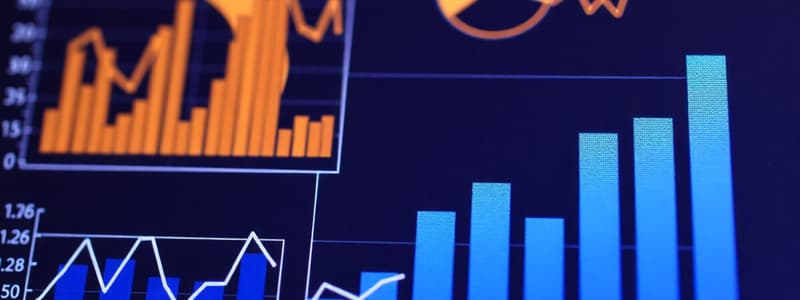Podcast
Questions and Answers
What is the relationship between data and information?
What is the relationship between data and information?
- Information is a form of data that has been analyzed to add context. (correct)
- Data can be directly observed and do not require processing.
- Data is a type of information that includes meanings and interpretations.
- Information is simply unprocessed data from surveys.
Which of the following is NOT a main source of demographic data?
Which of the following is NOT a main source of demographic data?
- Official records
- Census
- Vital registration
- Infrared surveys (correct)
What is one of the primary objectives of conducting a census?
What is one of the primary objectives of conducting a census?
- To analyze individual preferences in marketing.
- To estimate the population's economic conditions.
- To collect qualitative data on community satisfaction.
- To determine the total size of the population. (correct)
Which type of data is classified as qualitative?
Which type of data is classified as qualitative?
Which statistical technique is used to make predictions about a population from a sample?
Which statistical technique is used to make predictions about a population from a sample?
What do descriptive statistics primarily focus on?
What do descriptive statistics primarily focus on?
In a research context, which statement best describes the role of statistics?
In a research context, which statement best describes the role of statistics?
Which of the following best exemplifies inferential statistics?
Which of the following best exemplifies inferential statistics?
What is the primary function of statistics?
What is the primary function of statistics?
Which of the following correctly defines a parameter?
Which of the following correctly defines a parameter?
What is the primary difference between a sample and a population?
What is the primary difference between a sample and a population?
Which of the following is NOT a method of data collection in statistical analysis?
Which of the following is NOT a method of data collection in statistical analysis?
What type of statistics mainly focuses on understanding data variability?
What type of statistics mainly focuses on understanding data variability?
Which term best describes data that consists of observations regarding numerical values?
Which term best describes data that consists of observations regarding numerical values?
Which of the following is a key purpose of using graphs, tables, and charts in statistics?
Which of the following is a key purpose of using graphs, tables, and charts in statistics?
In statistical terms, who or what comprises the subjects in a medical study?
In statistical terms, who or what comprises the subjects in a medical study?
Flashcards
Data
Data
Any information or facts that are collected and analyzed to gain knowledge or understanding. It can be numbers, words, images, or any other form of representation.
Population (N)
Population (N)
The entire group of individuals or objects that a researcher is interested in studying. It can be a whole population, like all the people in a country, or a specific group, like all the students in a school.
Parameter
Parameter
A value that is calculated from the entire population. It could be the average height of all people in a country or the total number of cars in a city.
Sample (n)
Sample (n)
Signup and view all the flashcards
Statistic
Statistic
Signup and view all the flashcards
Subjects
Subjects
Signup and view all the flashcards
Descriptive Statistics
Descriptive Statistics
Signup and view all the flashcards
Inferential Statistics
Inferential Statistics
Signup and view all the flashcards
What is information?
What is information?
Signup and view all the flashcards
What is a census?
What is a census?
Signup and view all the flashcards
What is Qualitative data?
What is Qualitative data?
Signup and view all the flashcards
What is Quantitative data?
What is Quantitative data?
Signup and view all the flashcards
What are descriptive statistics?
What are descriptive statistics?
Signup and view all the flashcards
What are inferential statistics?
What are inferential statistics?
Signup and view all the flashcards
How are statistics used in research?
How are statistics used in research?
Signup and view all the flashcards
What kind of research can benefit from statistics?
What kind of research can benefit from statistics?
Signup and view all the flashcards
Study Notes
Introduction to Statistics
- Statistics is the field of mathematics focused on collecting, tabulating, and interpreting numerical data.
- It involves using mathematical models to analyze data from real-world studies and experiments.
Outline
- Definitions of Terms: This section will cover key terms used in statistics.
- Statistical Methods: This segment defines the various approaches for collecting data.
- Types of Statistics: Describes the difference between descriptive and inferential statistics.
- Difference between Descriptive and Inferential Studies: This explains the distinct approaches to analyzing data.
Definitions of Terms
- Statistics: A tool for organizing, summarizing, and communicating findings (data) clearly and meaningfully.
- Medical Statistics/Biostatistics: A science applying statistical principles to health-related issues.
- Data: The basic elements or building blocks of statistical analysis.
Importance of Statistics
- Statistics provides a clear and transparent picture of work processes.
- Statistical methods help analyze various fields like medicine, economics, business, and social sciences.
- Organized data presentation is achieved with graphs, tables, diagrams, and charts.
- Statistics enables an understanding of data patterns and variations.
- Statistics is a method and tool for accurate quantitative data acquisition.
Population and Parameter
- Population (N): All elements (people or things) whose characteristics are being studied.
- Parameter: A value about a population (e.g., mean, total, average), calculated from the entire population.
Sample and Statistic
- Sample (n): A subset of the target population selected for study, used to make inferences about the population.
- Statistic: A value representing a characteristic of a sample (e.g., sample mean), that can be calculated directly from the collected data.
Sample
- A sample comprises one or more observations from a population.
- Subjects are the units on which characteristics are measured, often humans, also cells in culture or animals for research.
Census vs Sample
- A census collects data from the entire population.
- A sample collects data from a representative subset of the population.
Statistical Methods
- A) Methods of Data Collection.
- B) Analytic Statistics.
- C) Methods of Data Presentation.
What is Data?
- Data are observations or evidence concerning the social world.
- Data can be quantitative or qualitative.
- Data is produced, not given; researchers select what to record.
Data and Information
- Information is processed data that is meaningful and useful.
- Data + Meaning = Information. (Example: Individual exam scores are data, but processing them to show boys scored higher than girls is information.)
Sources of Data
- Census
- Vital registration
- Official records
- Simple survey
- Individuals studied
Nature of Data
- Data can be classified into:
- Qualitative Data (or Attributes)
- Quantitative Data (or Variables)
Types of Statistics
- Descriptive/Deductive
- Inferential/Inductive
Descriptive Statistics
- Techniques to organize, display, and describe using tables, graphs, and summary measures.
Inferential Statistics
- Techniques using sample data to make predictions or inferences about a population.
Statistics and Research
- Applied in research studies for analyzing collected data.
- Examples of using statistics in research include determining preference differences and meaningful statistical differences in research participation.
Descriptive and Inferential Statistics
- Descriptive: Organizes, summarizes, and presents data.
- Inferential: Generalizes from samples to populations; tests hypotheses and assesses relationships among variables.
Types of Statistics (Another Classification)
- Descriptive Statistics:
- Measures of Central Tendency (mean, median, mode)
- Measures of Dispersion (range, variance, standard deviation)
- Inferential Statistics:
- Hypothesis Testing (z-test, t-test, ANOVA)
- Regression Analysis
Studying That Suits You
Use AI to generate personalized quizzes and flashcards to suit your learning preferences.




